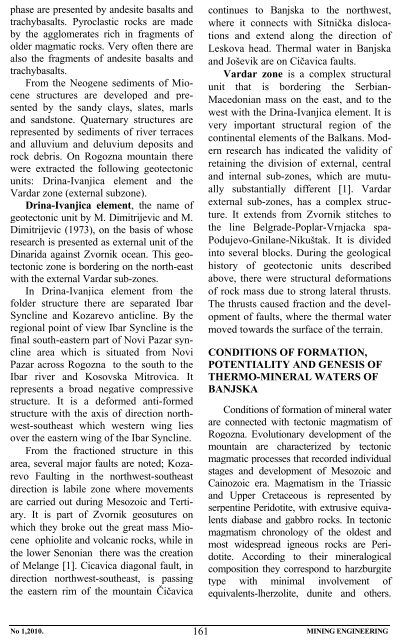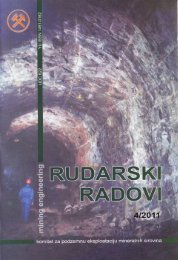Institut za rudarstvo i metalurgiju Bor
Institut za rudarstvo i metalurgiju Bor
Institut za rudarstvo i metalurgiju Bor
Create successful ePaper yourself
Turn your PDF publications into a flip-book with our unique Google optimized e-Paper software.
phase are presented by andesite basalts and<br />
trachybasalts. Pyroclastic rocks are made<br />
by the agglomerates rich in fragments of<br />
older magmatic rocks. Very often there are<br />
also the fragments of andesite basalts and<br />
trachybasalts.<br />
From the Neogene sediments of Miocene<br />
structures are developed and presented<br />
by the sandy clays, slates, marls<br />
and sandstone. Quaternary structures are<br />
represented by sediments of river terraces<br />
and alluvium and deluvium deposits and<br />
rock debris. On Rogozna mountain there<br />
were extracted the following geotectonic<br />
units: Drina-Ivanjica element and the<br />
Vardar zone (external subzone).<br />
Drina-Ivanjica element, the name of<br />
geotectonic unit by M. Dimitrijevic and M.<br />
Dimitrijevic (1973), on the basis of whose<br />
research is presented as external unit of the<br />
Dinarida against Zvornik ocean. This geotectonic<br />
zone is bordering on the north-east<br />
with the external Vardar sub-zones.<br />
In Drina-Ivanjica element from the<br />
folder structure there are separated Ibar<br />
Syncline and Ko<strong>za</strong>revo anticline. By the<br />
regional point of view Ibar Syncline is the<br />
final south-eastern part of Novi Pa<strong>za</strong>r syncline<br />
area which is situated from Novi<br />
Pa<strong>za</strong>r across Rogozna to the south to the<br />
Ibar river and Kosovska Mitrovica. It<br />
represents a broad negative compressive<br />
structure. It is a deformed anti-formed<br />
structure with the axis of direction northwest-southeast<br />
which western wing lies<br />
over the eastern wing of the Ibar Syncline.<br />
From the fractioned structure in this<br />
area, several major faults are noted; Ko<strong>za</strong>revo<br />
Faulting in the northwest-southeast<br />
direction is labile zone where movements<br />
are carried out during Mesozoic and Tertiary.<br />
It is part of Zvornik geosutures on<br />
which they broke out the great mass Miocene<br />
ophiolite and volcanic rocks, while in<br />
the lower Senonian there was the creation<br />
of Melange [1]. Cicavica diagonal fault, in<br />
direction northwest-southeast, is passing<br />
the eastern rim of the mountain Čičavica<br />
continues to Banjska to the northwest,<br />
where it connects with Sitnička dislocations<br />
and extend along the direction of<br />
Leskova head. Thermal water in Banjska<br />
and Joševik are on Cičavica faults.<br />
Vardar zone is a complex structural<br />
unit that is bordering the Serbian-<br />
Macedonian mass on the east, and to the<br />
west with the Drina-Ivanjica element. It is<br />
very important structural region of the<br />
continental elements of the Balkans. Modern<br />
research has indicated the validity of<br />
retaining the division of external, central<br />
and internal sub-zones, which are mutually<br />
substantially different [1]. Vardar<br />
external sub-zones, has a complex structure.<br />
It extends from Zvornik stitches to<br />
the line Belgrade-Poplar-Vrnjacka spa-<br />
Podujevo-Gnilane-Nikuštak. It is divided<br />
into several blocks. During the geological<br />
history of geotectonic units described<br />
above, there were structural deformations<br />
of rock mass due to strong lateral thrusts.<br />
The thrusts caused fraction and the development<br />
of faults, where the thermal water<br />
moved towards the surface of the terrain.<br />
CONDITIONS OF FORMATION,<br />
POTENTIALITY AND GENESIS OF<br />
THERMO-MINERAL WATERS OF<br />
BANJSKA<br />
Conditions of formation of mineral water<br />
are connected with tectonic magmatism of<br />
Rogozna. Evolutionary development of the<br />
mountain are characterized by tectonic<br />
magmatic processes that recorded individual<br />
stages and development of Mesozoic and<br />
Cainozoic era. Magmatism in the Triassic<br />
and Upper Cretaceous is represented by<br />
serpentine Peridotite, with extrusive equivalents<br />
diabase and gabbro rocks. In tectonic<br />
magmatism chronology of the oldest and<br />
most widespread igneous rocks are Peridotite.<br />
According to their mineralogical<br />
composition they correspond to harzburgite<br />
type with minimal involvement of<br />
equivalents-lherzolite, dunite and others.<br />
No 1,2010. 161<br />
MINING ENGINEERING



